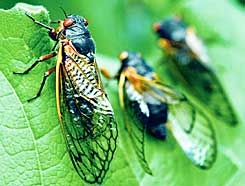Avi Blizovsky and Aryeh Seter

The 2004 cohort died, the 2021 cohort was born - cicadas in the USA, in June. Before her death, each female laid about 600 eggs
Direct link to this page: https://www.hayadan.org.il/cicades0704.html
Their humming serenades died away. The sky was emptied of air. Their carcasses, which flooded the sidewalks, disappeared. The 2004 cycle of cicadas is gone.
However, on the trees in several states in the USA - mainly on the East Coast and the Midwest, the next generation of cicadas begins its life cycle - of 17 years, which begins underground and ends on the sidewalks and roads in American cities.
In the coming weeks, billions of white cicada larvae, no bigger than sesame seeds, will hatch from the eggs attached to the tree branches. The larvae, with bright red eyes, will dig their way into the tree roots, which they eagerly suck, and will not emerge from underground until 2021, 17 years later.
According to Gene Kritsky, a biology professor at Mount St. Joseph's College in Cincinnati, most people won't notice the path the cicada larvae take until they reach the ground because the larvae are so small. However, if they observe them at the right time, they will see a kind of rain of jets coming down from the trees.
Billions of cicadas have flooded large areas of the USA in the last two months - from New Jersey to Virginia, in southern states like Tennessee and parts of Ohio and Indiana. The cicadas emerged from their hiding places under the trees, shed their skin and flew away. The males made loud mating calls.
However, in mid-June the cicadas began to die. The last action of the cicada females, before they left the world, was to lay their eggs - about 600 eggs each.
The world is a dangerous place for larvae hatched from egg nests. On their way to the excavations under the ground, the larvae become a main target for predators such as insects and cockroaches. And if the ground is too hard, they can't reach the roots of the trees. According to Mike Raup, an entomologist from the University of Maryland in the US who followed last summer's cycle of cicadas, the mortality rate of the larvae in the first two years is around 90%.
The question arises, why do these cicadas spend their childhood phase, so many years in the ground and why exactly 17 years?
If such a long life cycle is not an amazing enough fact, then another amazing fact is that two more species of cicadas with a multi-year life cycle are known - one in which the life cycle is also 17 years (which may have developed independently and separately from the famous cicadas of the eastern USA) b) And another species whose life cycle is 13 years.
What is special about the numbers 13 and 17 that different species of cicadas have chosen such numbers of years, as the length of their life cycle?
The answer is that these two numbers are prime - and not so small (smaller are 11, 7, 5, etc.)
This evolutionary tactic is called flooding. The species that reproduces quickly and surprises its predators and its food sources at once, chances of surviving and passing this trait on to the next generation are high. In the case of the cicadas it reached the point of absurdity.
For news in the San Jose Mercury
They know evolution in action
https://www.hayadan.org.il/BuildaGate4/general2/data_card.php?Cat=~~~897413860~~~197&SiteName=hayadan
